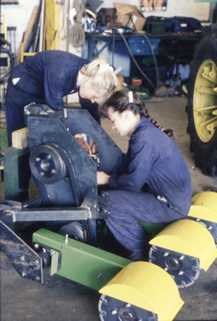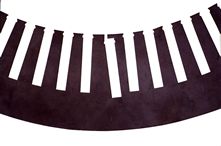
|
|
||||||||
ACDMM Example Projects
3. Sugar Beet Topper
 As
part of the harvesting process, the tops of sugar beet are normally cut
off by a horizontal knife. An ingenious design - known as a skew-bar topper
- had been designed for the Mark 3 version of the host company's machine
and this increased yield by 1 tonne per hectare. The structure of their
Mark 2 harvester was unsuitable for a retrofit of the new equipment. However,
there were some 700 Mark 2s in service and a team of three A.C.D.M.M.
graduates was asked to design a skew-bar unit that would fit between the
tractor and harvester. They obtained an understanding of beet and cropping
methods, carried out a market survey, produced draft ideas and had one
accepted, produced detailed designs, built and commissioned their prototype,
all in a total time of 5 weeks.
As
part of the harvesting process, the tops of sugar beet are normally cut
off by a horizontal knife. An ingenious design - known as a skew-bar topper
- had been designed for the Mark 3 version of the host company's machine
and this increased yield by 1 tonne per hectare. The structure of their
Mark 2 harvester was unsuitable for a retrofit of the new equipment. However,
there were some 700 Mark 2s in service and a team of three A.C.D.M.M.
graduates was asked to design a skew-bar unit that would fit between the
tractor and harvester. They obtained an understanding of beet and cropping
methods, carried out a market survey, produced draft ideas and had one
accepted, produced detailed designs, built and commissioned their prototype,
all in a total time of 5 weeks.
4. Slotting of Large Electric Motor Laminitions
 Very
large electric motors have their laminations made in segments and the
host company had purchased a machine for doing this. It had been designed
to cut 1100 slots per minute but, if it was run at more than 700, it produced
misplaced slots in a totally unpredictable manner and neither the host
company nor the German press manufacturer had been able to solve the difficulty.
By using a stroboscope and then logical analysis, a three-man A.C.P.M.M.
team established that it was the punch stripper mechanism that was at
fault. Its actuating springs were found to be Bellville washers and these
had been assembled incorrectly. This fault was remedied and the machine
then performed to its original specification. The total cost to the firm
was merely that of a few packing washers!
Very
large electric motors have their laminations made in segments and the
host company had purchased a machine for doing this. It had been designed
to cut 1100 slots per minute but, if it was run at more than 700, it produced
misplaced slots in a totally unpredictable manner and neither the host
company nor the German press manufacturer had been able to solve the difficulty.
By using a stroboscope and then logical analysis, a three-man A.C.P.M.M.
team established that it was the punch stripper mechanism that was at
fault. Its actuating springs were found to be Bellville washers and these
had been assembled incorrectly. This fault was remedied and the machine
then performed to its original specification. The total cost to the firm
was merely that of a few packing washers!